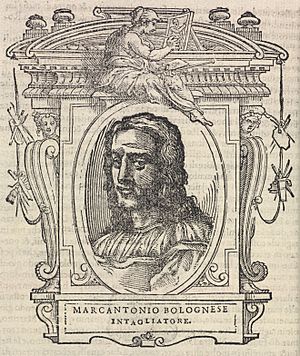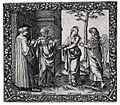Marcantonio Raimondi facts for kids

Marcantonio Raimondi, often known as Marcantonio, was a famous Italian engraver who lived from about 1470/82 to 1534. He was one of the first important artists to create many prints by copying famous paintings. This made him a key person in spreading art through "reproductive prints." He also developed a special way of engraving that became very popular in Italy and other places.
Working with the famous painter Raphael helped Marcantonio's career a lot. Even after Raphael died in 1520, Marcantonio kept making prints of his art. This helped spread the beautiful High Renaissance art style all over Europe. We know a lot about Marcantonio's life from a book called Lives of the Artists by Vasari. Marcantonio is believed to have made around 300 engravings.
Contents
Marcantonio's Life Story
Starting as an Artist
We don't know Marcantonio's exact birth date, but it was no later than 1482. He was probably born in a place called Argine, near Bologna, Italy. He grew up there and learned his art skills from Francesco Francia, a top goldsmith and painter in Bologna.
Vasari, the historian, said that Marcantonio quickly became better than his teacher. He started designing and making fancy belt buckles and other items using a technique called niello. This is where you engrave metal and fill the lines with a different colored metal. However, some experts like Arthur Mayger Hind don't think he started with niello.
We don't know of any paintings Marcantonio made, but some of his drawings still exist. His first dated engraving, called Pyramus and Thisbe, was made in 1505. Before that, he made other undated works. From 1505 to 1511, Marcantonio created about 80 pieces. These included many different subjects, from old pagan stories to religious scenes.
His early works were his own ideas, mixing styles from his teacher Francia and other artists from northern Italy. Like other Italian printmakers at the time, he was greatly influenced by the amazing prints of Dürer, which were very popular in Italy. Marcantonio even used parts of Dürer's landscapes in his own work and copied his techniques. Dürer was in Bologna in 1506, as was Michelangelo, and Marcantonio might have met them.
Copying Famous Art
Around this time, Marcantonio began making copies of Dürer's woodcut series, called the Life of the Virgin. Copying art was very common back then. Usually, engravers copied expensive engravings, not cheaper woodcuts. But Dürer's woodcuts were so good that they raised the standard for this type of art. Since Marcantonio kept copying many of Dürer's engravings and woodcuts, it must have been a good way to make money.
His early copies even included Dürer's famous AD monogram (a special symbol). Dürer complained to the government in Venice. He won some legal protection for his monogram, but not for his art designs, in Venice. This was an important step in the history of intellectual property law, which protects artists' creations. Marcantonio likely spent some time in Venice during the late 1500s, but we don't know the exact dates.
Working in Rome
Around 1510, Marcantonio traveled to Rome. There, he joined the group of artists who worked with Raphael. Raphael's influence started to show in Marcantonio's engravings, like The Climbers. In this print, he copied part of Michelangelo's Soldiers surprised bathing, also known as Battle of Cascina. After Marcantonio made a copy of Raphael's work called Lucretia, Raphael personally helped and taught him.
Another famous engraving is the Judgement of Paris, made in 1515 or 1516, after Raphael's design. This engraving later inspired Édouard Manet when he painted The Luncheon on the Grass.
Marcantonio and Raphael started a successful printing business with a man named Il Baveria. This business quickly grew into an engraving school, with Marcantonio as the head teacher. Some of his most talented students included Marco Dente (Marco da Ravenna), Giovanni Jacopo Caraglio, and Agostino de Musi (Agostino Veneziano).
Later Years
Marcantonio and his students continued to make engravings based on Raphael's art, even after Raphael passed away in 1520. Often, Marcantonio didn't copy the finished paintings. Instead, he worked from Raphael's early sketches and drafts. This way, he created different versions of the same idea, and they were quite popular.
Marcantonio faced some trouble and was arrested. However, with help from important people like Cardinal Ippolito de' Medici, Baccio Bandinelli, and Pietro Aretino, he was released. After his release, he began working on an engraving called Martyrdom of St. Lawrence, based on a design by Bandinelli.
During the Sack of Rome in 1527, Marcantonio was forced to pay a large amount of money to the Spanish soldiers. He then fled the city in poverty. It's not clear where he lived after leaving Rome until his death in 1534.
Images for kids
-
Joseph and Potiphar's Wife, made around 1520.
See also
 In Spanish: Marcantonio Raimondi para niños
In Spanish: Marcantonio Raimondi para niños




